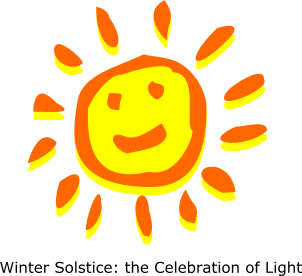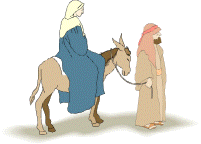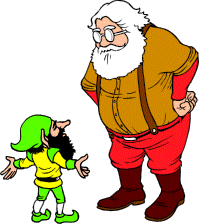
Liberal Reasons Not to Celebrate Christmas
I am a liberal. I do not celebrate Christmas. This isnít because I awoke one morning to find a green-skinned, evil-smiling, finger-drumming Grinch in my mirror. On the contrary, I still celebrate the season's high festivity and generosity, but on a different date (the Winter Solstice, usually December 21), and with a different set of customs.
The reasons Iíve rejected Christmas are economic, environmental, social and religious. The fact is, Christmas today has become a thoroughly illiberal event, at odds with everything that liberals stand for.
The economic reasons

Polls show that many people believe Christmas has become too commercialized. It should be a time of family celebration, friendship, spirituality and reflection. Unfortunately, almost all methods of celebrating Christmas nowadays require spending money.
So great is the social pressure to spend that 44 percent of all Americans feel they spend too much on Christmas gifts. In 1998, Americans will spend between $160 billion to $200 billion on presents — more than two-thirds the Defense budget! (Thatís about $600 to $800 per person.) This doesnít include the 5 billion Christmas cards, letters and packages that will be sent through the mail. Nor does it include the traveling expenses of nearly 50 million Americans who will travel over 100 miles during the Christmas and New Years holidays.
Few people realize that Christmas produces more income inequality than any other time of year. Wal-Mart is the largest Christmas merchant in America, and itís not an accident that its founder, Sam Walton, would have been the second richest man in America if he were alive today. (His $55 billion fortune would have put him within inches of Bill Gatesí $58 billion!)
There are two main reasons why Christmas dramatically worsens income inequality. The first is concentrated profits. Everyone may trade wealth at Christmas in the form of gifts, but the profits accrue to the few: namely, retail stores. And not all retail stores, either: a few large stores like Wal-Mart, K-Mart and Target have been taking over the market in the last decade, while smaller stores find themselves increasingly disadvantaged. Much of this has to do with todayís deregulated economy, which makes the rich richer and the poor poorer.
The second reason Christmas causes inequality is the business cycle. Most of us know business cycles by the recurring recessions and recoveries that happen about once a decade. Almost no big businesses fail during recessions, because they have more money and resources to ride them out. However, small businesses donít — they fail by the hundreds of thousands during recessions, and sprout by the hundreds of thousands during recoveries. In fact, 99.9 percent of all business failures and openings are small businesses. What this means is that, over time, big businesses steadily increase and consolidate their market advantages. This is an important reason for growing income inequality.
Now, it turns out that Christmas also creates a boom and bust cycle, only on a yearly basis. Heightened Christmas spending causes retail stores to make 50 percent of their profits in the last three months of the year. This produces a sales drought in January and February, and weakens the rest of the year as well. Predictably, small business failures mirror this seasonal trend, adding to the nationís income inequality.
I should point out that a disproportionate share of small business owners are women, minorities and the working poor. It is liberal constituencies who are being hurt by these booms and busts, and this should compel liberals everywhere to spread out their spending over the whole year, especially among small businesses.
There are other economic problems as well. Christmas is replete with market failures (or inefficient allocation of resources). Social custom prevents people from asking others what kind of gifts they want, so they often have no idea of the recipientís wants, tastes or needs. Suboptimal gifts range from wrong dress sizes to inedible fruitcakes to snowy water balls. This, of course, necessitates the infamous "gift return." As most merchants will concede, post-Christmas stampedes to return gifts often resemble pre-Christmas stampedes to buy them. This market failure represents a significant and tangible cost to society. To solve this problem, more and more people are resorting to gift certificates. But when everyone exchanges gift certificates, they might as well forgo the fiction of gift-giving and buy their presents themselves.
Another market failure is the unacceptably high purchase of single-use items, such as real Christmas trees, gift-wrapping, artificial frost, crepe paper, party favors and the like. Reusable and recyclable merchandise would save society money, but that would hurt the Christmas industry, which is why they donít market these items.
The environmental reasons

As the last paragraph suggests, using items once and throwing them away incurs not only an economic cost, but an environmental cost as well.
Take Christmas trees. In 1997, Americans cut down 33 million real trees to put up in their homes, enough to cover the state of Rhode Island. In doing so, they spent somewhere between $600 million to $1.1 billion. Our population explosion has reached the point where we now need 1 million acres of land for Christmas tree farms. These farms take the place of wild habitats or, even worse, old-growth forests. Of course, tree farms do not have the biodiversity or habitability that natural land or old-growth forests have. If people must farm this land at all, let it be for food. Likewise, the 100,000 employees of the Christmas tree industry could be put to better use.
As with all big business, there is a Christmas tree lobbyist group, called the National Christmas Tree Association. Part of their public relations effort is to defend their environmental destruction. Real trees, they point out, are biodegradable. And for each tree cut, 2 to 3 seedlings are planted. Furthermore, each acre of growing Christmas trees provides the daily oxygen requirements of 18 people. But all these arguments forget that old-growth forests already do these things on their own — and far better and more abundantly than pesticide-soaked tree farms.
And synthetic trees? Although they are reusable, synthetic trees in fact have an average life span of only six years. They are made from petroleum by-products, are non-biodegradable and will sit in landfills for centuries. Their production requires vast resources and is itself environmentally harmful. And to add insult to injury, a great many artificial trees are produced in China, which brings us to the next objection:
The social reasons

"Made in China" is the label youíll find on many Christmas trees and most childrenís toys. Unfortunately, China frequently uses prison labor to manufacture these goods, and the prisoners are often political dissidents jailed by the Butchers of Tienanmen Square. This doesnít seem to faze the lobbyists of the U.S. toy industry, who see American children playing with toys produced under Communist tyranny as vital to Americaís economic health.
How much does Communist China contribute to Americaís Christmas? In the first nine months of 1997, they exported over $450 million in artificial Christmas trees, ornaments, lights and lamps. They further shipped over $2.2 billion in dolls and stuffed toys, 10 times the amount made in America in 1995.
Another social problem with Christmas is stress. Polls routinely show that most Americans consider Christmas to be the most stressful holiday of the year. And the number one irritant of Christmas? Fighting crowds in stores.
Another source of stress is the family reunion. Although we should certainly consider family get-togethers a positive thing, the truth remains that many families are dysfunctional, and reunions only serve to open old wounds. Statistics show that suicide rates remain about average during November and December, but they spike on New Years day, after most people return home and have the first chance to act on their depression. Society could lessen the stress and tension of Christmas and family reunions alike if it did not pressure people to celebrate it with mass consumerism and other frenzied customs.
The religious reasons

Thousands of years before Christianity even appeared, cultures all around the world were celebrating a similar holiday, with many of the traditions that we now associate with Christmas.
What these cultures celebrated was the Winter Solstice, or the shortest day of the year. This usually occurs on December 21. For various reasons, ancient cultures celebrated this holiday at different times in December or early January.
Why did these many cultures celebrate the Winter Solstice? Because from here on the days will get longer and warmer. It is a holiday of optimism, that the sun will win in its battle over darkness. It is also a holiday of rebirth and fertility, for the lengthening sun will eventually allow farmers to plant their crops. Light is an intrinsic part of most of these celebrations, whether it be sunlight, candles, bonfires, Yuletide logsÖ or todayís Christmas lights. Not for nothing do most cultures start their New Year about this time.
The first evidence that we have of a Solstice celebration is Mesopotamia from 4,000 years ago. Solstice celebrations have been found in every part of the ancient world, from China to Native America.
The Solstice celebration that Christianity drew on was the Roman holiday Saturnalia. During these celebrations, people suspended all work and indulged in great feasts and drinking. They decorated their homes with greenery of all sorts (for greenery was the product of sunlight, of course). This ranged from wreaths made of laurel to trees adorned with candles. Gifts were sometimes exchanged, especially with small children. But the most interesting aspect of the holiday was the reversal of social order. Wars were suspended, quarrels forgotten, debts forgiven. Slaves exchanged places with their masters, and children became head of their families. In fact, the Romans went so far as to crown a mock king ó "the Lord of Misrule." The holiday, needless to say, was extremely popular with the people.
In 274 A.D., the Roman Empire was still "pagan" (that is, not yet Christianized). In that year, the Emperor Aurelian proclaimed that December 25 would be the birthday of the "Invincible Sun."
In 336 A.D., Emperor Constantine Christianized this holiday, proclaiming it to be the birthday of Jesus. The date is almost certainly wrong; the Bible doesnít say when Jesus was born. However, it was most likely in spring, the only time that ancient shepherds ever watched over their flocks by night.
It is interesting to note that as Christmas spread throughout Europe, it absorbed the Winter Solstice customs of other countries. For example, when Christianity spread to Scandinavia, it found Scandinavians celebrating the Winter Solstice with Yule logs, mistletoe, holly, legends about elves, and Yule goats who carried presents from the gods.
Now, letís examine the implications of these facts. Curiously, everyone should have a historical gripe with Christmas, whether conservative or liberal, Christian or non-Christian!

If you are a Christian, the fact that Christmas is a rip-off of pagan rituals should be completely unacceptable. Christís birth was not December 25, and none of todayís secular customs celebrate it. Furthermore, the Christ of the Gospels was an advocate of the poor; countless texts tell of his scorn for greed, money and the rich. The same goes for Saint Nicholas, the 4th Century Myran bishop who secretly gave anonymous gifts to the poor. The crass commercialization of Christmas today makes a mockery both Christian history and belief.
If you are a non-Christian, then of course the Christianization of the holiday should be unacceptable to you.

If you are a conservative, then Christmas should be objectionable because it hardly conserves the traditions of the past (which is the dictionary definition of conservatism). It is interesting to note that the vast majority of Christmas customs observed by Americans today were adopted only in the last 400 years, not the last 2,000 years.
If you are a liberal, then the objections are too numerous to mention. The ancient people celebrated the overturning of hierarchy; namely, the poor becoming equal to the rich, the slave becoming equal to the master, the citizen becoming equal to the king. But todayís holiday actually strengthens hierarchy and income inequality.
Furthermore, Christmas as practiced in modern America is deeply Euro-centric and Christian. The original holiday had multi-cultural roots from all over the world. Christian conservatives call these roots "pagan," but "pagan" is a racist epithet meaning "heathen" and "uncivilized." Our society should move beyond such prejudice.
What is the best solution to this dilemma? Let Christians move the birth of Christ to its more likely historical date (spring), and let them create their own customs, based on the Biblical accounts of Jesus' birth. Meanwhile, let the rest of us celebrate the Winter Solstice on its true date every year. How should we celebrate it? There is no one answer, since each culture has celebrated it differently. One attractive answer is: celebrate it however you want, after any culture you want.
I would make only one economic suggestion: trade services instead of goods as gifts. With a good, a merchant somewhere gets part of your money. With a service, your loved one gets 100 percent of your work effort. Let individuals buy their goods themselves; they know what they best want or need.
And with that, I wish you a Happy Winterís Solstice.

Sources:
Economic reasons: Americans spend too much: U.S. News/Bozell poll of 1,003 adults conducted by KRC Research Nov. 6-10, 1996, with consulting by U.S. News pollsters Celinda Lake of Lake Research and Ed Goeas of the Tarrance Group. Total Christmas spending: $160 billion figure from David Segal, "Retail Outlets are Bracing for Many Unhappy Returns," Washington Post, December 25, 1997. $200 billion figure derived from "Americans More Generous at Christmas than Europeans" Reuters, November 27, 1998. Mail volume: "Christmas in America: Some Statistics in Your Eggnog," AP wire service, December 24, 1997. Travel statistics: AAA survey of 1,500 adults in "Can Last-Minute Shoppers Rescue a Retail Slump?" CNN online, December 24, 1997. Sam Walton: Forbes 400 Richest People in America, Forbes magazine, October 12, 1998. Walton would have been the second richest man in America had he lived; his Wal-Mart empire has since been divided among his heirs. Largest retail stores increasing market dominance: Dougal Casey, "Retail Consolidation," White Paper (International Council of Shopping Centers, 1998). Deregulated economies increasing inequality: Kevin Phillips, Politics of Rich and Poor (New York: Random House, 1990). Small businesses representing 99.9 percent of turnover: U.S. Bureau of the Census data cited by U.S. Small Business Administration, Small Business Answer Card Ė 1998. Retail holiday profits: "Retailers Get Jump on Xmas," CNN online, October 12, 1998. Women and minority small business owners: see "The New American Revolution: The Role and Impact of Small Firms," (U.S. SBA, 1998) and "Characteristics of Small Business Employees and Owners," (U.S. SBA, 1997). Volume of Christmas returns: Rachel Beck, "Christmas Sales," AP wire service, December 26, 1997; see also Segal, cited above.
Environmental reasons: all statistics cited in this passage are taken from the National Christmas Tree Associationís website, located at http://www.christree.org/welcome.html.
Social reasons: Chinaís export statistics: "Christmas in America: Some Statistics With Your Eggnog," cited above. Christmas stress and aversion to crowds: "Time to Shop," Mercury News Center, San Jose Mercury News, 1997, citing National Retail Federation; Deloitte & Touche survey of 1,000 consumers and 500 retailers, October 1997; America's Research Group survey of 1,010 adults, Oct. 26-30, 1997. Holiday suicide rates: National Center for Health Statistics, as reported in Michael Woods, "Holiday Blues? Bah, Humbug," Pittsburgh Post-Gazette, December 4, 1995, p. A9. Note that suicide is correlated to separation from the group, and New Years is the first time that most people are alone after a stressful family reunion. See Emile Durkheim, The Elementary Forms of Religious Life, Joseph W. Swain, trans. (Glencoe, IL.: Free Press, 1954 [original 1912]).
Religious reasons: Histories of Winter Solstice celebrations, Saturnalia and the evolution of Christmas: Earl W. Count, 4,000 Years of Christmas (New York: Henry Schuman, 1948), republished in 1997 by Ulysses Press; Richard Heinberg, Celebrate the Solstice: Honoring the Earth's Seasonal Rhythms (Wheaton, IL: Quest Books, 1993); Steven Nissenbaum, The Battle for Christmas (New York: Knopf, 1996).
 Return to Liberalism Resurgent
Return to Liberalism Resurgent
Help Fight the Right! -- Support Liberalism Resurgent.
© Copyright 1998 by Steve Kangas. Text can be quoted freely for non-commercial purposes only, with proper attribution.